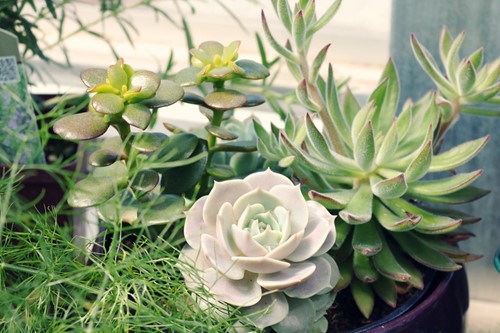Email: [email protected]

Succulents are an excellent choice for houseplant beginners. They don’t have any strict watering requirements and are hardy enough to survive indoors in almost all climates. However, there is a difference between your succulents surviving and thriving. Here we will go over some basic tips to make sure your succulents are the best they can be.
There are over 100 varieties of succulent, each with their own characteristics and needs. While all of them share the same basic traits, it’s a good idea to research what types of succulents will work best for your environment. For example, aloe is a very popular succulent famous for the soothing gel produced from its leaves. However, aloe is toxic to cats and dogs, so it might not be the best choice for those with pets. Many varieties of succulent are completely pet-safe, including the flower-shaped echeveria and some of the trailing succulents like sedum and string of hearts. Others like snake plant and jade, while very popular, pose a risk to animals and humans if ingested.
Other things you should learn about your choice in succulents are whether they thrive or burn in direct sunlight and what time of year they are dormant. This will help you avoid damage and over-care of your plants so they can flourish in your home.
Succulents store excess moisture in their leaves in order to survive in their native desert climates. This is an attractive characteristic for many houseplant beginners because it means they do not require fastidious watering schedules. However, it also means it’s very easy to water them too much. Succulents only require watering every two to four weeks and only after the soil has completely dried out. In their dormant seasons you should water them even less. Over-watering your succulents can lead to root rot, which will eventually kill the plant entirely.
The best way to avoid over-watering your succulents is to make a note of when you water and water the right way. Unlike tropical plants, succulents don’t like humidity, so avoid misting or drenching the leaves when you water. Watering from the bottom using a shallow basin is the easiest way to soak the soil without harming the top of the plant. After that, err on the side of under-watering rather than over-watering. A thirsty plant is much easier to treat than a drowned or rotting plant.
Soil is crucial for happy succulents in the same way that light and water are. Because succulents need to dry out completely between watering days, it’s important to get well-draining soil rather than soil that retains moisture. You can find succulent or cactus-specific potting soil at most garden centers or online. Good succulent soil will be gritty and include tiny particles of rock and organic matter like bark. This allows the water to flow through slowly but completely and ensure healthy roots.
The last thing on the list of basics is using the proper container. Always pot your succulents in a container with a drainage hole at the bottom. If you don’t mind the look, it’s perfectly fine to keep them in the basic plastic nursery containers you bought them in. Often you can fit those into your more aesthetically pleasing planters and pots and remove them when it’s time to water. Otherwise, make sure there is adequate drainage so the extra moisture can escape through the bottom.
It’s convenient that over 100 varieties of a plant share the same basic needs, but always look into the specifics of your new plants. Making sure they have the right amount of light, water and the proper growing environment will keep them not only alive but thriving.

Active in residential brokerage since 1985, Michael enjoys a loyal following of past buyers and sellers. Prior to entering brokerage, he studied culinary arts and managed restaurants in the Boston area. Born and raised in Newton, Michael is very familiar with the Greater Boston area. His seven-day-a-week commitment to his profession serves his clients and customers well. His educational background includes The Johnson & Wales Culinary Institute, The Lee Institute for Real Estate, and The Tom Hopkins and Floyd Wickman Sales Training courses.
In recognition of his completion of the prescribed courses in real estate practice and ethics, Michael has earned the distinguished GRI (Graduate, Realtor Institute) designation. He continues his long-standing membership in the National Association of Realtors and is an avid fly fisherman, musician, and outdoor enthusiast.
Michael was awarded the International President's Circle Award for sales expertise, market knowledge, and dedication to clients for 2020 and 2021. In 2022 and 2023 he was awarded the International Presidents Elite Award, representing the Top 2% of Hammond Residential & Coldwell Banker Agents Worldwide, for demonstrating exceptional sales production, ambition and his commitment to the Real Estate Industry.